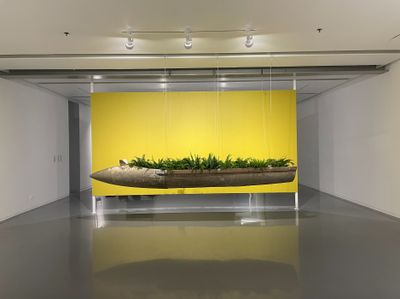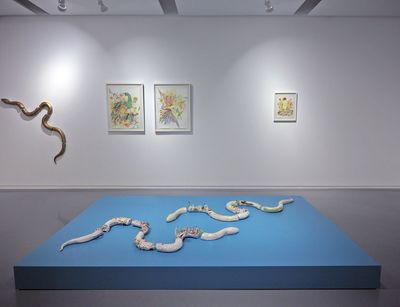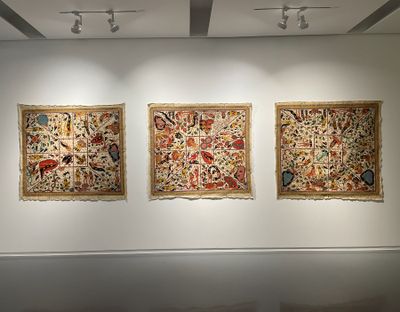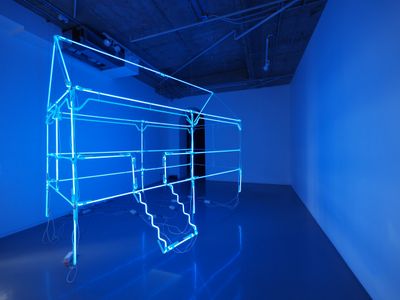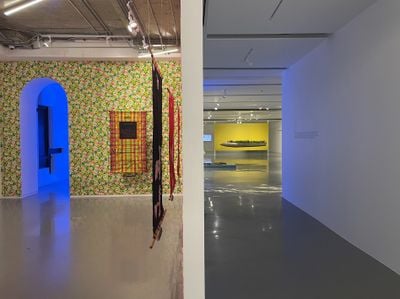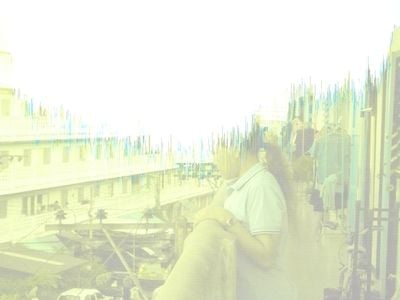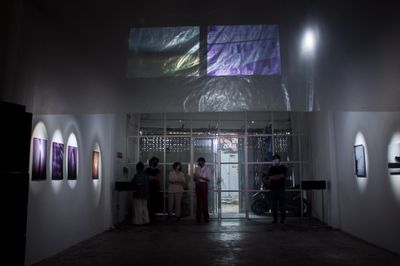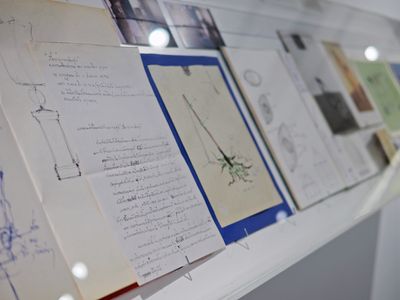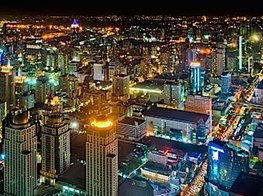Blurring the Borders of Southeast Asian Art in Bangkok
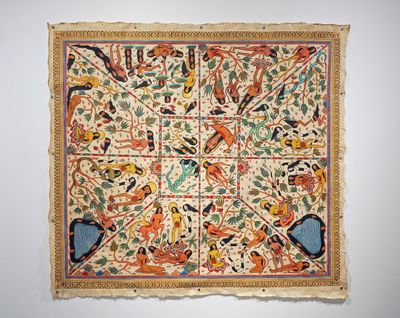
Citra Sasmita, Timur Merah Project VI, Into The Land of Beast-God (2021). Acrylic on Kamasan traditional canvas. 155 x 145 cm. Courtesy the artist.
Two distinct shows in Bangkok organised by JWD Art Space and Protocinema unveil cultural intricacies at the margins of nation states, highlighting key curatorial stakes in Southeast Asian art.
A Life Beyond Boundaries (The Geography of Belonging) at JWD Art Space (1 June–30 September 2021) is an ambitious gathering of works by 15 artists from Cambodia, Indonesia, Laos, Malaysia, Myanmar, the Philippines, Thailand, and Vietnam.
Curated by Loredana Pazzini-Paracciani, the show is inspired by Benedict Anderson's eponymous book, his late memoir in which he discusses how he came to theorise the nation as an 'imagined community' in reference to his ground-breaking book published in 1983.
Fictional flags composing Indonesian-born artist Boedi Widjaja's A cry a voice and a word that shall echo (2021) open the show, echoing the entry hall of an international organisation. Referencing ideals voiced during the 1955 Afro-Asian Conference in Bandung, each flag is a graphic transposition of sound recording to colours through Morse code: a synesthetic encoding for a true international yet to come. One of them unexpectedly recalls the geometric pattern of the Buddhist flag, a supranational symbol.
In the next room, Lie of the Land (2017) by Lao artist Bounpaul Phothyzan achieves an impressive mutation. As a relic of the Vietnam War on the Laos side, an American bombshell has been transformed into a floating vessel covered with greenery.
The installation is not only striking as a symbol of the healing power of vernacular culture and art, but is also an incongruous sample of U.S.-Laos Shared Built Heritage, a concept coined by the International Council on Monuments and Sites to identify the cultural heritage resulting from multi-cultural (often colonial) influence.
Abutting on an ochre wall, the work's design may also recall a hanging coffin—an ancient funeral custom that has been practiced by various ethnic groups in Southern China, Indonesia, and the Philippines, adding to the salvational dimension of the assemblage.
Next to this are two ceramic sculptures by Soe Yu Nwe, Budding Serpent and Pink Serpent (2018), which seem to crawl on a blue surface like sea snakes. Although they are cut into pieces, the reptiles are empowered by a surprising effervescence, their spermatic heads and phallic shape transcending the categories of masculine and feminine thanks to pastel hues, iridescent effects, and trans-species mutations.
A mastery of opposites catches the eye: animal versus vegetal, hard versus soft, continuity versus discontinuity, the artist blends the yin and the yang. Born in a Chinese family in the Eastern part of Myanmar and educated in the United States, Soe has an affinity for the snake. From the Chinese zodiac to deities in Hinduism and Buddhism, the snake is a cultural chameleon, and a mirror of her own cultural hybridity.
Snakes reappear in Citra Sasmita's series of paintings entitled Timur Merah Project VI (2021), also, in which the artist pursues the renowned Kamasan tradition of painting from Bali, male characters have been replaced with female figures to empower post-patriarchal narratives: a unique serial composition of impaled bodies and pervasive vulvas.
As for Cambodian artist Vuth Lyno, his suspended neon installation Sala Samnak (2020) looks like a surreal shelter: a luminous architecture that levitates within the gallery space. In Sanskrit, 'sala' often identifies a covered pavilion, enabling the artist to refer to an open and public space commonly found in South and Southeast Asia, while 'samnak' (or 'samreak') means 'to rest' in Khmer, in reference to the gradual disappearance of 'resting halls' in Cambodia.
Sala Samnak's design overrides the commercial origins and aggressive nature of neon as a media, with peaceful blue light radiating as an invitation to pause: a poetic meditation on fraternity and openness.
Such a timely deconstruction of national narratives opens up Southeast Asian art to make it genuinely global.
While most artworks in A Life Beyond Boundaries either hang from the ceiling or lay on the ground, the two-and-a-half metres long golden thread composing L.I.N.E (2021) by Thai artist Wantanee Siripattananuntakul traces a symbolic junction between. The precious metal is pinned from the floor to the angle of walls, striking in its discrete presence.
If the single location of JWD Art Space offers a cohesive and centripetal approach, A Few In Many Places at Monitor Lizard House (11 June–30 July 2021) heralds a centrifugal perspective. Organised by the cross-cultural art organisation Protocinema, the show is one of the satellites of a multi-site exhibition that spans New York to Seoul through Guatemala City, Santurce, Istanbul, and Bangkok.
Curated by Mari Spirito and Abhijan Toto, the Bangkok part of this group show displays Frequent Collaborator (2021), a video installation and photography series by Thai artist Komtouch Dew Napattaloong, accompanied by the sound work of Thanart Rasanon.
One of the central pieces of the exhibition is a video documenting the life of Hmong refugees from Vietnam in Thailand. The project continues the artist's long-term investigation into refugees and asylum seekers, a focus motivated by the fact that Hmong people are split between several countries and have been members of the Unrepresented Nations and Peoples Organization since 2007.
The recruitment of Hmong collaborators by the CIA during the Vietnam War has also increased their vulnerability in Southeast Asia since then. In one revealing scene in Napattaloong's film, an old Hmong lady recently displaced from Vietnam to Thailand narrates the story of an ancient Hmong King killed by the Chinese and held captive in a stone tomb, his spirit prevented from returning to his people.
Filmed alone in a humble room, the lady then comments on a bag manufactured in China copying Hmong patterns, before looking at a Hmong music performance on a smartphone. This is one of the work's many moving insights into the intangible heritage in Hmong culture, and paradoxical condition of Hmong people today: being disowned of their rich culture and having no space to live, they remain colonised in a so-called post-colonial era.
The situation of Hmong people relates to the concept of Zomia, developed by anthropologist and political scientist James C. Scott in his book The Art of Not Being Governed: An Anarchist History of Upland Southeast Asia (2009). The author uses it to describe the biggest remaining area of earth whose inhabitants have not been completely absorbed by nation states.
Zomia forms a forest belt that stretches from Northeast India, through the tropical heartland of Southeast Asia to the Philippines, encompassing the hilly and mountainous lands of that region. Often mentioned by Abhijan Toto in his curatorial work—including the core mission of Forest Curriculum, the art collective that he co-founded with Pujita Guha in 2018—the concept is an enlightening reference to the rich cultural interspaces of nation states epitomised by the Hmong ethnic group.
With that in mind, these two exhibitions capture more than the zeitgeist of Southeast Asian art. Rather, they tap into the spirit of the place—its ortgeist, one may say.
Such an epiphany is not unprecedented. Shows like No Country: Contemporary Art for South and Southeast Asia, curated by June Yap and inaugurated at the Solomon R. Guggenheim Museum in New York in 2013, have paved the way for greater attention to minority and diasporic identities in South and Southeast Asian art, while transcending physical and political borders.
But the congruence of these two shows in Bangkok in 2021 lends a theoretical complementarity: an emphasis on the supranational and subnational that echoes a set of Bangkokian collectives that share similar approaches. Such as Blur Borders, a performance art forum established in 2007 by Thai artists Mongkol Plienbangchang and Aor Nopawan, and the Museum of Something, an experimental art base founded in 2020 offering an underground alternative to the national narratives.
This archaeology of the contemporary delivers a compelling discourse. Such a timely deconstruction of national narratives opens up Southeast Asian art to make it genuinely global. —[O]



